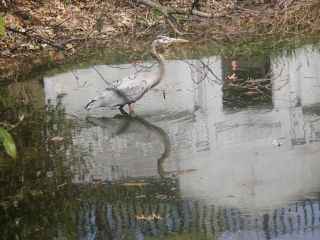April 30, 2008
Socializing at the Cemetery

warbler shot by inadequate camera
Since June busted out all over in April, I've been hanging out a bit at Mt. Auburn, our "garden" cemetery - final resting place of many a poet and patrician, bird sanctuary and horticultural heaven. I was partaking of the pollen and working my way up to shooting the usual thousand flower pictures I feel compelled to take every spring, when, quite by chance, I bumped into a small but interesting social scene which I'm assuming happens often among the gravestones of a sunny afternoon. The friendly bird photographers were all steamed up about the elusive ruby crowned kinglet, and ever so ready to take me under their wings, so to speak, even though my mini Olympus was a eighth of the size of one of theirs. All three hang enough big brand cameras and binoculars around their necks to strangle an ordinary citizen. Sometimes they walk alone, but often in a quiet pack.
Last week they were stalking the ruby crowned kinglet, ("a bird on cocaine") this week, the Baltimore oriole. These guys are a hoot, and they know everything -- where the coyotes live and how many cubs they had last year, how the Canadian geese are discouraged from taking up residence (I forget), all about bad birding manners (crypt and step ladder ascents seen often during warbler week). They dislike baby strollers, especially squeaky wheels or squeaky babies. In fact most children are not trained in the art of bird stalking, and generally behave in bird disturbing ways. They hang out with the blue heron hoping to catch him with a bullfrog in his beak with a froggy legs extended, and reminisce about the day they shot him spearing an orange carp.
They taught me the basics Look up and scan the trees until you see movement. Since I'm very myopic and have so many floaters , I see movement everywhere. Fortunately, there's a fallback - listen for a bird call, hear who's around, and then look up. Then take out your camera, make the necessary adjustments and shoot. Then see if you shot a bird. Then see if it's in focus. Then make sure you didn't shoot a robin or a grackle, or if you did, that the boring bird is doing something interesting like building a nest or flying upside down. Every once in a while you hit the birdy jackpot. Lord knows it must have been an expensive hobby before digital cameras came along, since so many shots come out looking like some woodpecker was behind the camera. Frankly, it's all quite thrilling when you get a good one, rather like catching a fish without the worms or the need to be inhumane.
The deficiencies of my camera for this exciting game soon became very clear to me. I can only capture the big slow birds like heron and swans , who are tame enough to pose for an audience. I'm looking at a faster model, so that I may delight my audience with further birdy scenes of nature.
The guys tell me that they are just the tip of the iceberg, The Brookline Bird Club, some 1500 strong, has a special key to the gates of Mt. Auburn, and in high season 200 afficionados arrive each morning at 6:30AM for prime viewing.
You can take a virtual bird tour around Mt. Auburn, and get a better idea of the challenges a bird shooter faces.
Photo note: An art shot, where the bird is only a design element. You can see that my warbler shot will never do for the National Geographic, but I got it!
Posted by Dakota at April 30, 2008 08:10 AM